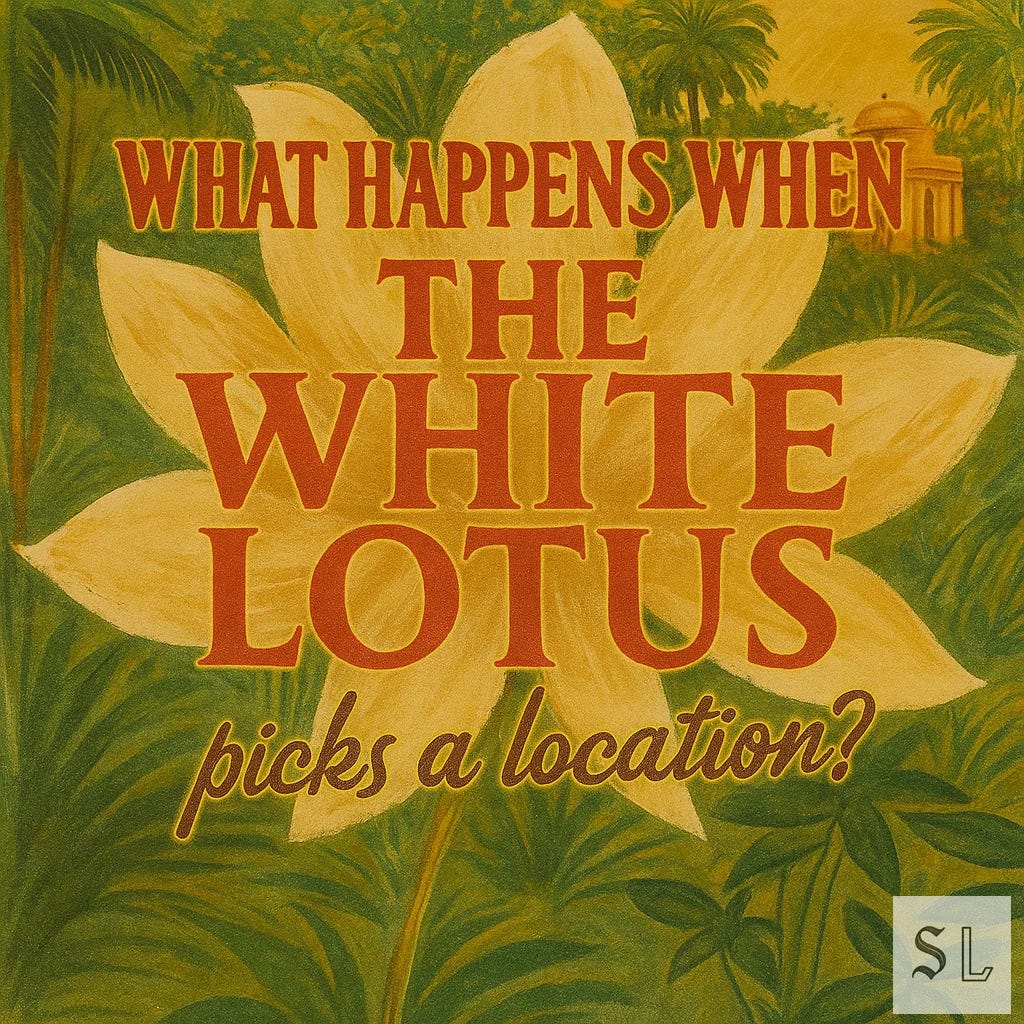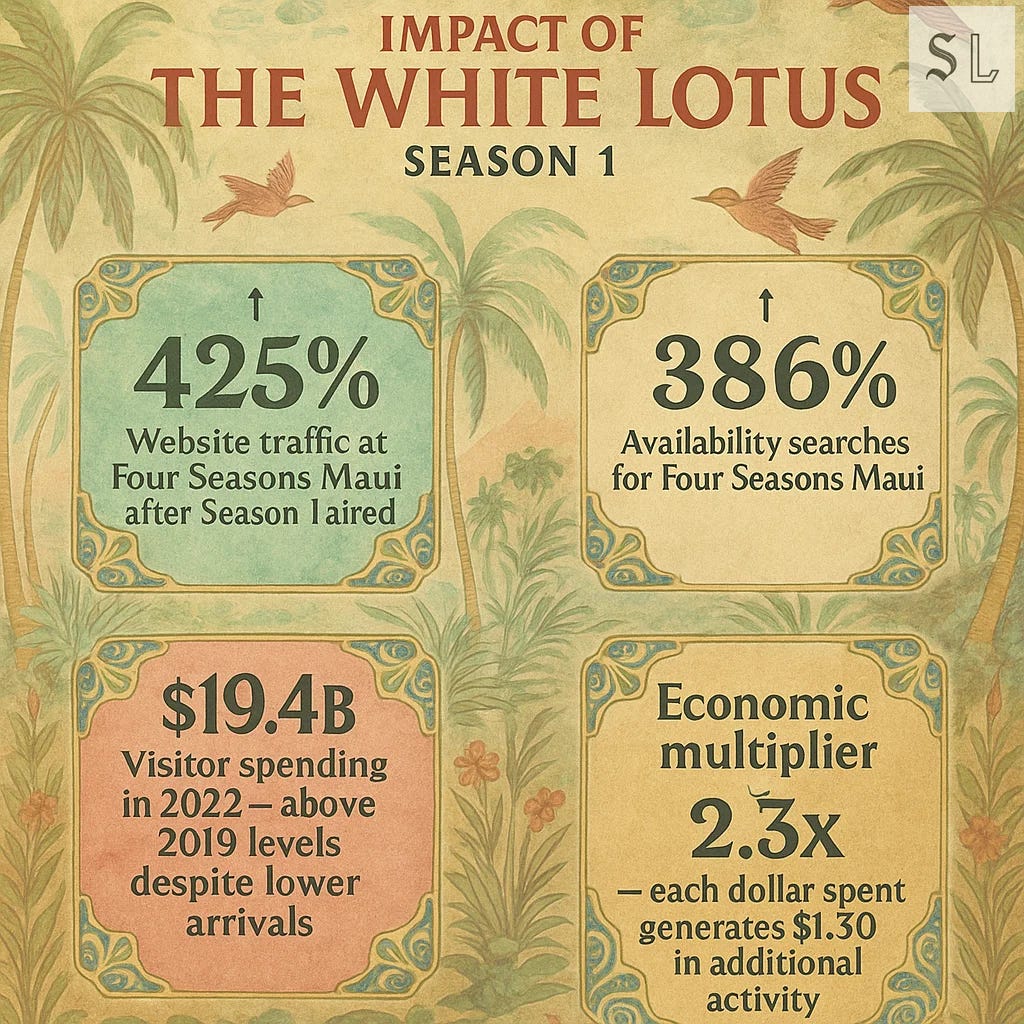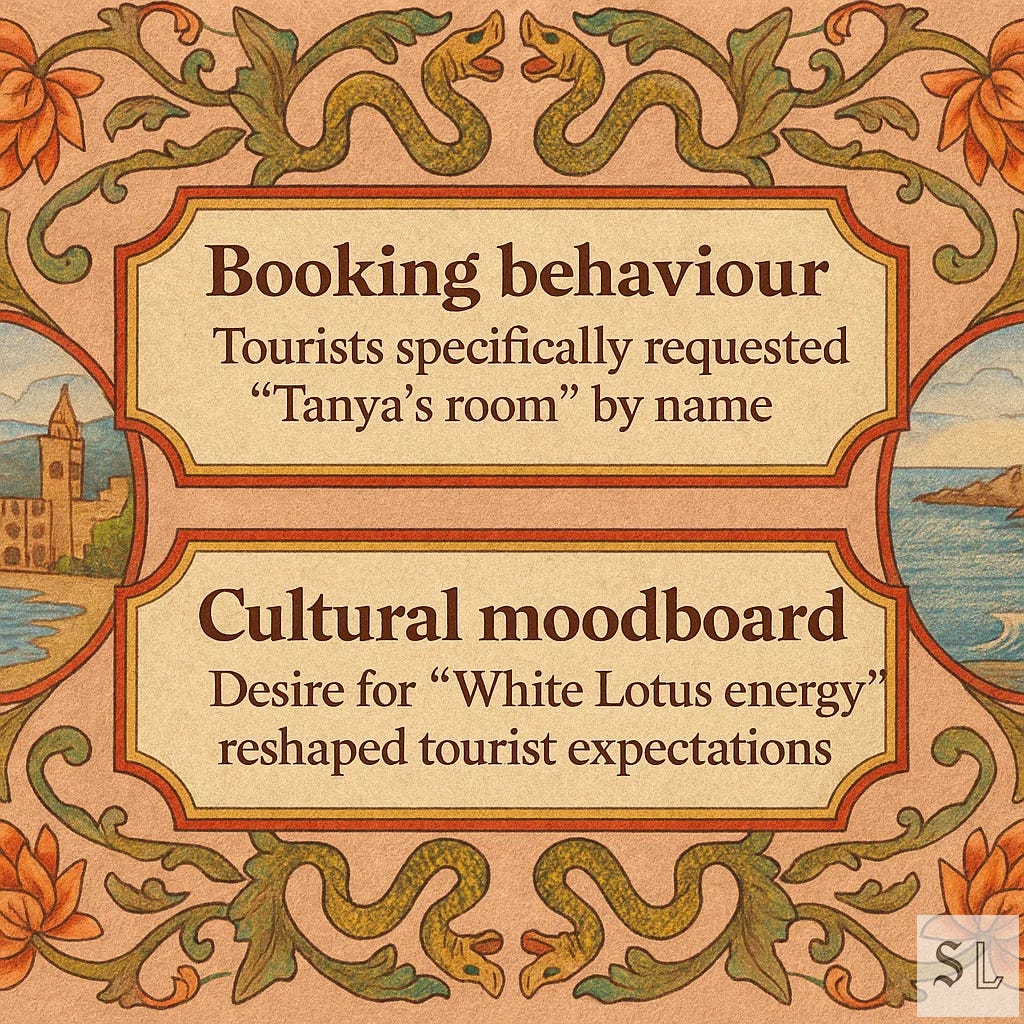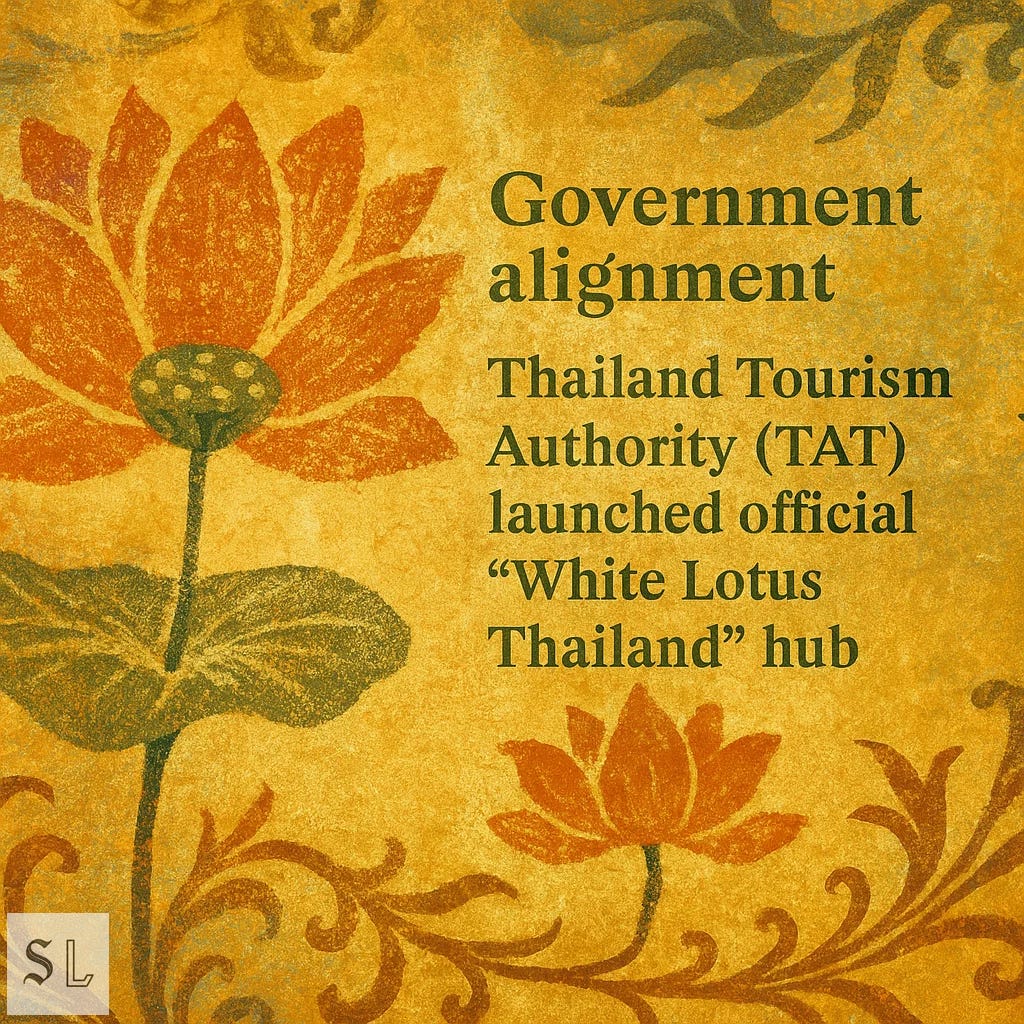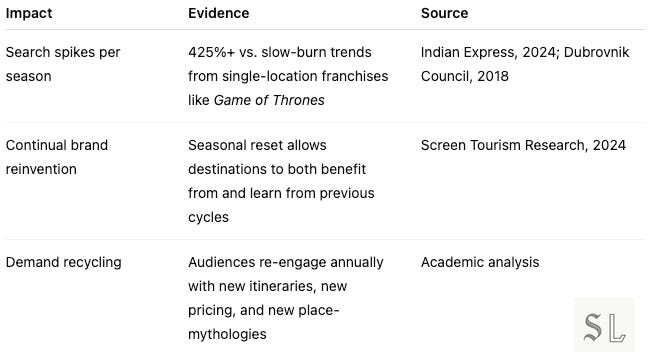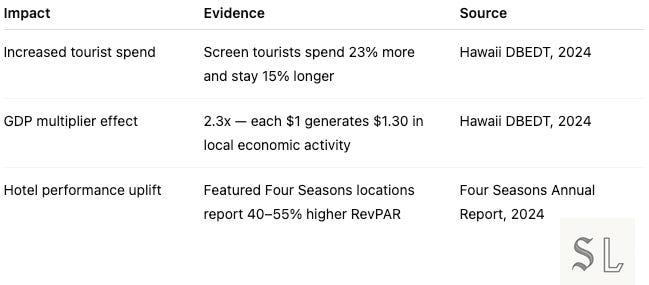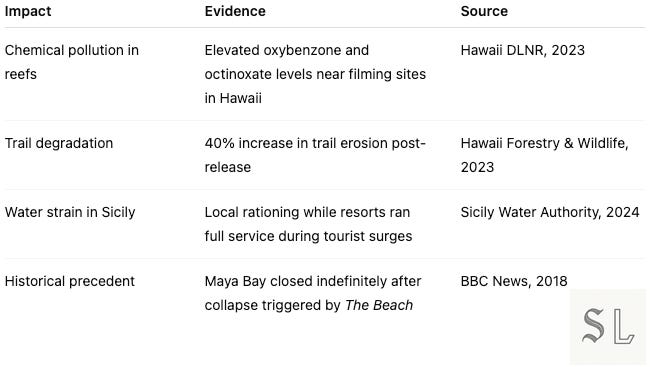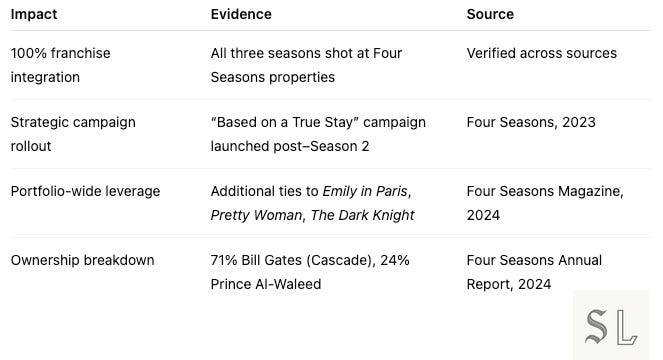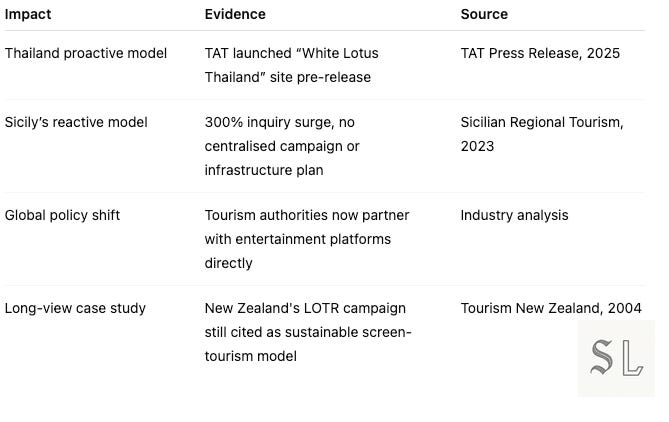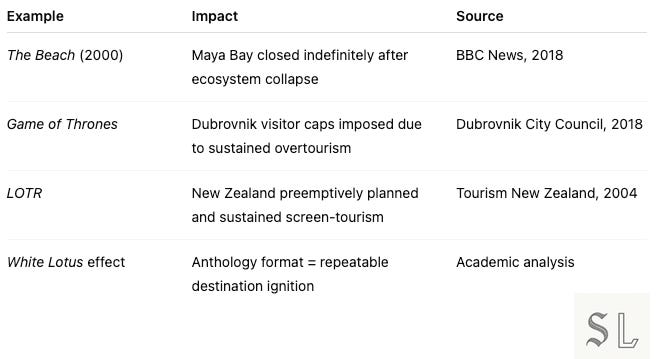What happens when The White Lotus picks a location?
The Show That Critiqued Rich People on Holiday and Then Sold Out Their Suites
This piece is part of System Studies: Travel, an ongoing Strange Loop series investigating how attention rewires geography and what happens when a place becomes an “It Place.”
For paid subscribers, you get exclusive essays, the entire catalogue, and now a bonus Cheat Sheet: a bite-sized, dinner-party-ready summary of the data, insights, and absurdities — because not everyone at the table read the full 5,000 words, but you did. And now you have jokes and citations.
Let’s begin.
You didn’t go to Sicily, you went to the set.
No — worse — you went to the meme of the set.
Or maybe not even that. You went to prove you knew it was a set, and that you could afford to rent the joke.
You weren’t deluded, you were self-aware. You were in on it. You understood the layers — the irony, the decay, the deranged beauty of it all. You even used the quote in the caption.
This is what happens when a show about the performance of wealth spawns a global performance of watching others perform wealth. Not as parody, not as critique, but now as itinerary.
It’s also what happens when the hotel — a Four Seasons — removes its own name from the show credits just so you have to Google it, figure it out, and reward them for their absence. An anti-branding strategy so effective it turned into shareholder value.
Because none of this is “just a vibe.” There are receipts. There are 425% booking spikes, €5,000 suites, coral reef warnings, landlord pushback, water rationing, and state-backed microsites designed to catch your search traffic and convert it to GDP. Thailand even launched its tourism portal before the season aired.
And funnily enough, none of this was even supposed to happen. The White Lotus wasn’t born as a global tourism engine. It was a pandemic fix. A production constraint.
But HBO aired it anyway, and somewhere between Emmy campaigns and dinner party postmortems, it started minting destinations.
We’ve all wondered: What happens to a place when The White Lotus chooses to film there?
Today we’re talking about:
How The White Lotus transformed from pandemic workaround into a global tourism engine
Why set-jetting now drives policy, pricing, and infrastructure — not just travel trends
The quantifiable fallout from Season 1 in Hawaii, including reef damage and rental inflation
How Season 2 turned Sicilian melancholy into a €5,000-a-night booking funnel
What Season 3 revealed about pre-release government coordination in Thailand
The 7 systemic effects that followed: from Four Seasons' asset strategy to state-level tourism planning
And what it means when critique doesn’t discourage consumption but scripts it
What Is Set-Jetting — And Why Does It Matter?
Call it what you want — set-jetting, screen tourism, HBO-core pilgrimage — the outcome’s the same: you see it on TV, then you book it. Preferably before your friends, but ideally with a stronger grasp of the mise-en-scène than they had.
Once, that kind of behaviour belonged to superfans: a Game of Thrones obsessive in Dubrovnik, a Sex and the City brunch tour. Niche, contained, and only slightly cringe.
But The White Lotus didn’t stop at generating fandom, it also generated itinerary. No cosplay, lore, or merch. Just you, a €1,600/night suite, and a performance of knowing detachment from the very thing you came to inhabit.
And what used to be a cultural side effect has calcified into infrastructure.
According to Expedia:
66% of travellers considered visiting a location they saw on screen in 2024 — up from 39% in 2022
White Lotus destination searches spiked 300%+ per season
Set-jetting was listed as one of Expedia’s Top Travel Trends of the Year
And with Season 4 already doing location scouting, it’s time to look at The White Lotus not as a series, but a system — a prestige-format tourism engine operating on annual release cycles. Each new location functions like a product drop: Hotels scramble, governments align, and audiences, fluent in HBO’s tone of winking despair, book their way into the plot.
Let’s break down the three seasons.
Case Study #1: Hawaii (Season 1) — The Soft Launch of Meta-Tourism
Maui wasn’t ready and, apparently, neither was the Four Seasons. The resort was unbranded, the campaign non-existent, and still the phones rang.
What began as a pandemic workaround quietly became the dry run for a new category of travel: aesthetic immersion for irony-literate audiences. No one said it out loud, but everyone found out where it was filmed, and the moment they did, it sold out.
Pandemic Origin Story: Why The White Lotus Was Never Meant to Be This
Conceived in 2020 as an emergency HBO fill-in project, The White Lotus wasn’t part of a long-term franchise plan. Mike White pitched it as a contained, quickly produced series to fill gaps left by paused productions due to COVID-19.
Filming location: Four Seasons Maui at Wailea — chosen specifically because:
The hotel was shut down during the pandemic.
Cast and crew could quarantine and live on-site.
The isolated, single-location shoot helped control exposure risk and reduce logistical complexity.
The entire production was effectively a COVID-safe filming bubble.
HBO greenlit it on an accelerated timeline, just six months from pitch to shoot — a rarity in premium television.
According to HBO exec Casey Bloys and showrunner Mike White, it was designed as an “anthology-style limited series” (meant to run once).
Its success was unplanned. Only after critical acclaim and audience engagement did HBO commission follow-ups.
And boy was there engagement:
The numbers aren’t ambient uplift, they’re cause-and-effect. The White Lotus aired, and Maui’s tourism economy surged: traffic up 425%, booking intent up 386%, and total visitor spend exceeding pre-pandemic highs. But the quant only tells half the story. What followed was a pattern of cultural commodification, marine degradation, and housing pressure. It was the qualitative impact that would quietly set the tone for everything the franchise touched next.

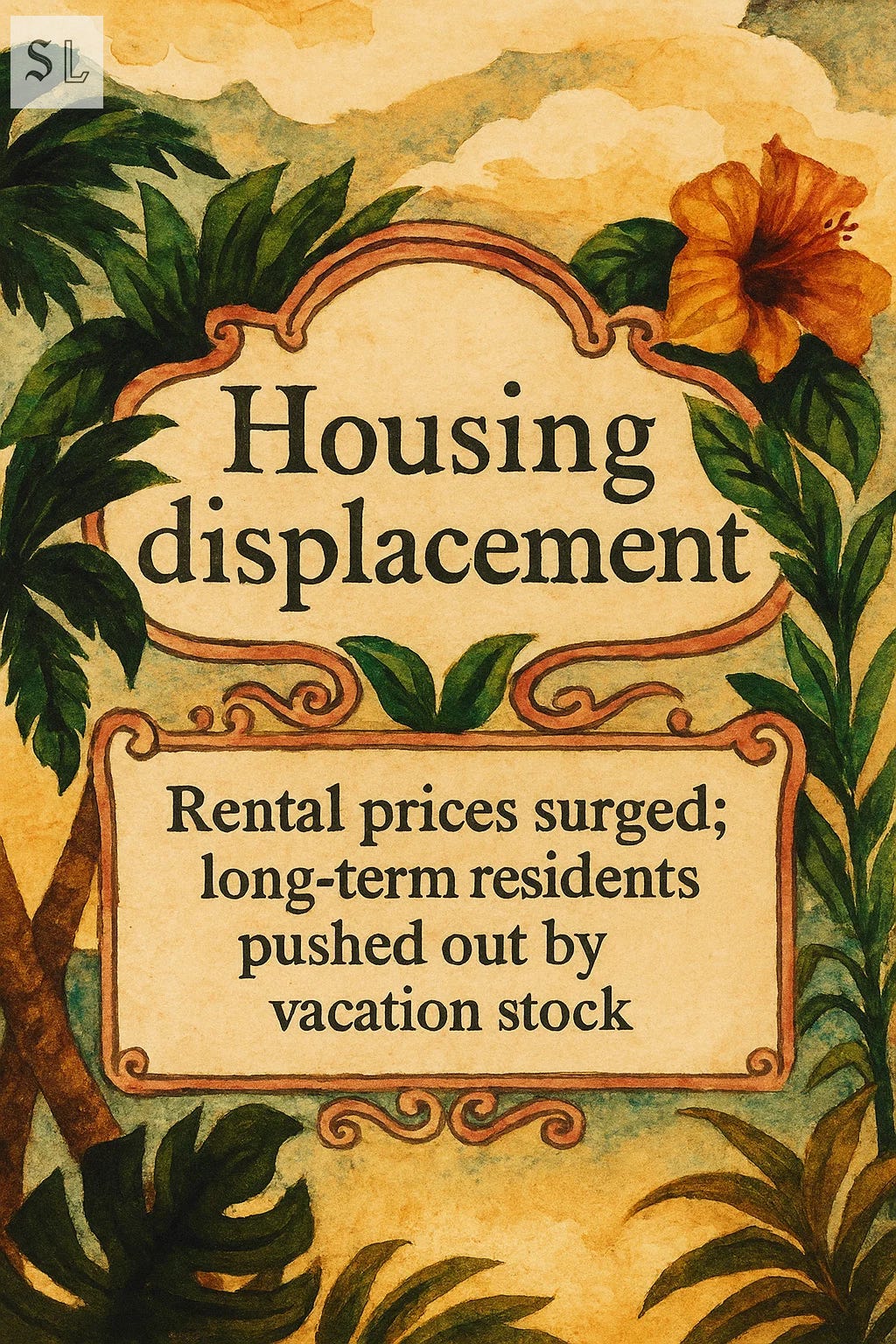
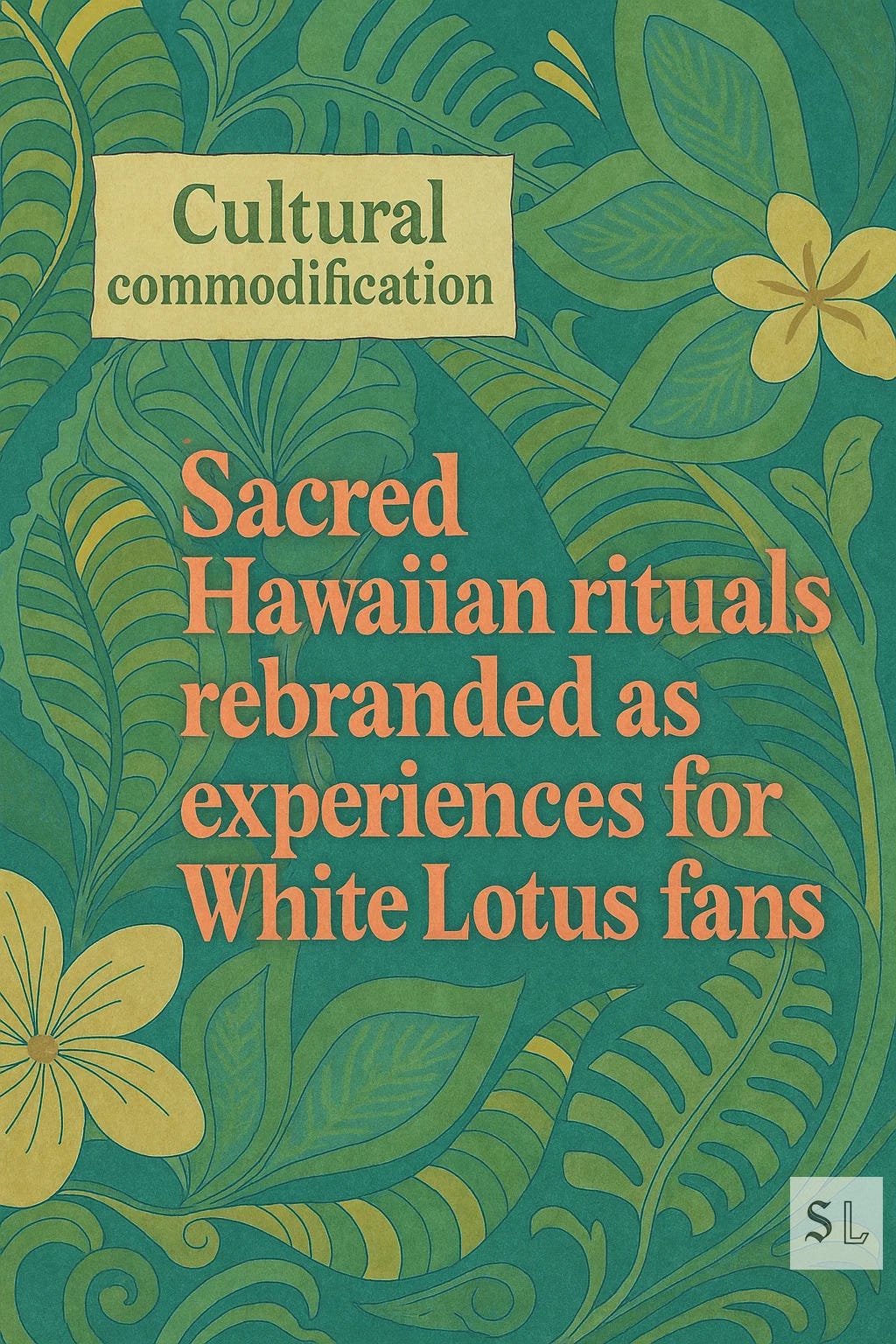
What the data doesn’t show is what it displaced.
There is no assumption The White Lotus intended to trigger ecological strain or housing pressure.
But it set the stage for something larger: a template for understanding how prestige media exposure reshapes a place - and all the good and the bad that goes along with that.
Marine scientists recorded elevated levels of reef-damaging chemicals in nearby waters. Housing officials flagged a sharp rise in short-term rentals and price surges that squeezed out long-term residents. And Native Hawaiian groups reported a wave of cultural tourism that rebranded sacred rituals into beachfront packages. There was no warning, no policy, no plan — just a sudden influx of attention that Maui wasn’t asked to prepare for, and no mechanism to manage what came next.
What Season 1 Taught Us:
The satire didn’t repel desire, it rehearsed it. The White Lotus didn’t just attract luxury tourists; it offered everyone else the blueprint for how to act like one.
Case Study #2: Sicily (Season 2) — Tragedy Becomes a Booking Engine
If Season 1 caught everyone off guard, Season 2 didn’t. The moment Taormina’s cliffs hit HBO’s feed, the destination was already absorbing its new role.
Unlike Maui, this wasn’t a surprise surge. This was a scripted landfall, and the numbers show it wasn’t just fans paying attention, it was all of the operators.
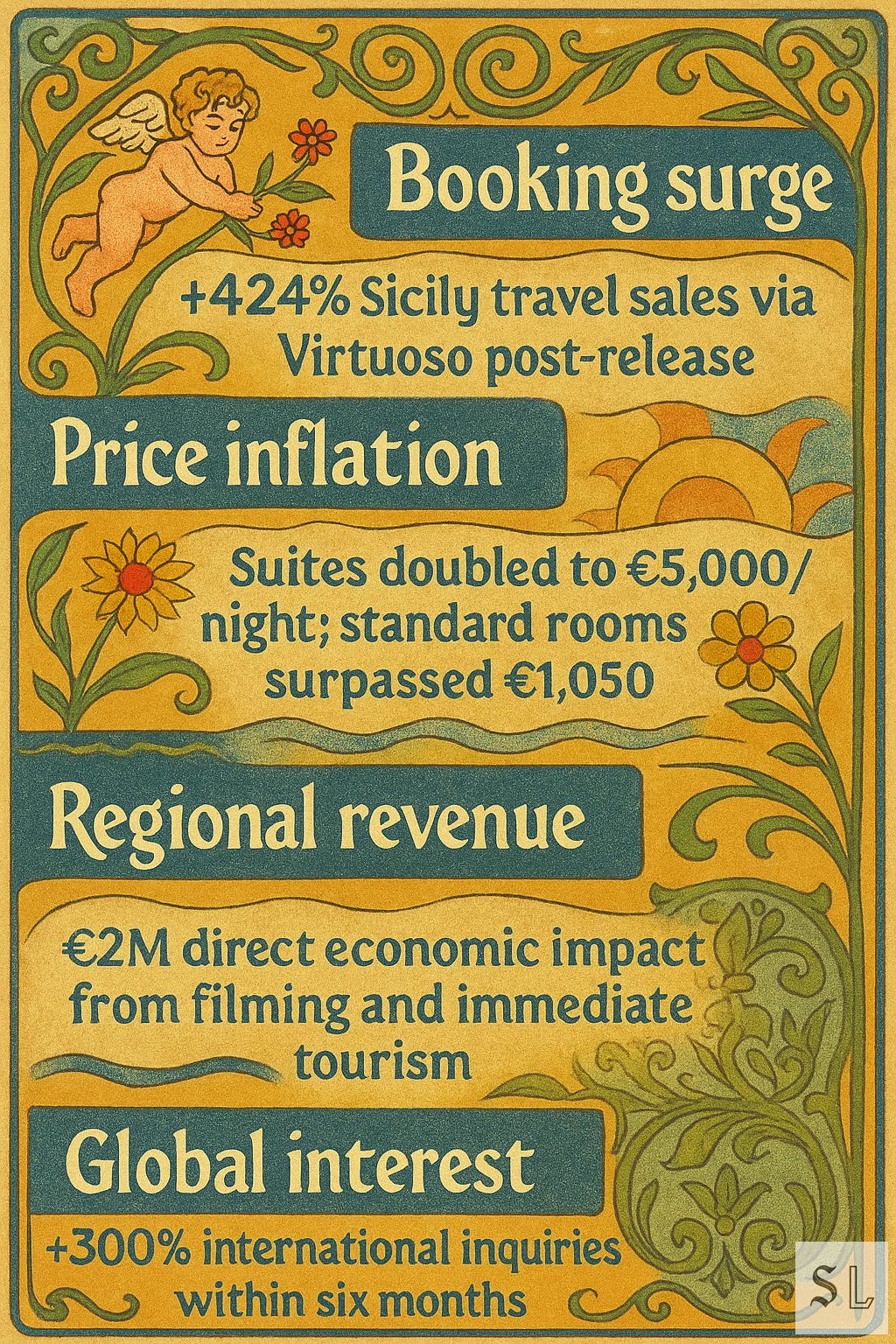
The town didn’t just fill. It rebranded.
Bookings surged over 400%. The San Domenico Palace was sold out for months. Suite prices spiked to €5,000 a night. Visitor inquiries from abroad tripled in under six months.
Taormina became the melancholy twin of Amalfi — same coastal palette, but infused with HBO-grade doom. Taormina went from Italian location appeal to global narrative residue. Travel editors leaned in. Hotels leaned harder. Everyone knew the scene with the Vespa. And for a few thousand euros, you could stay in the aftermath of someone else’s tragedy… and tag it.
But then, of course, the other side:
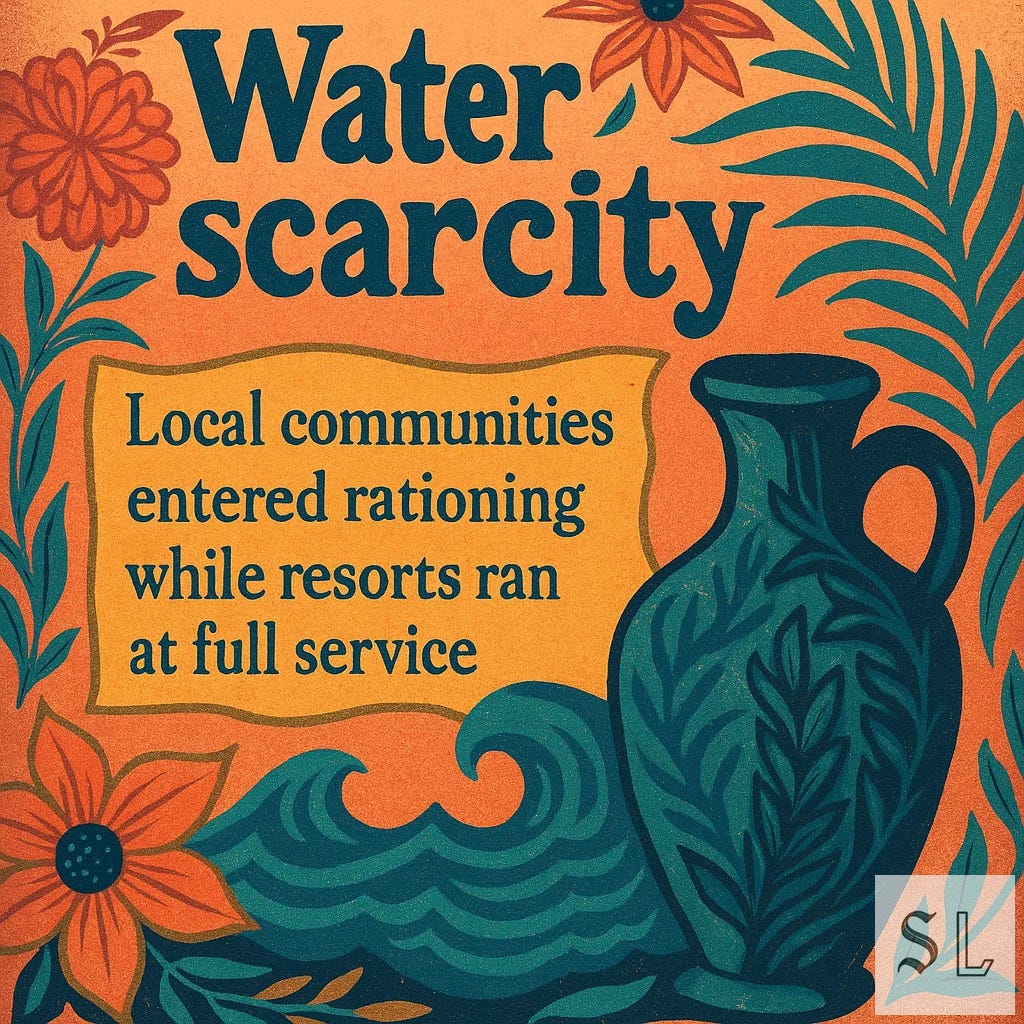
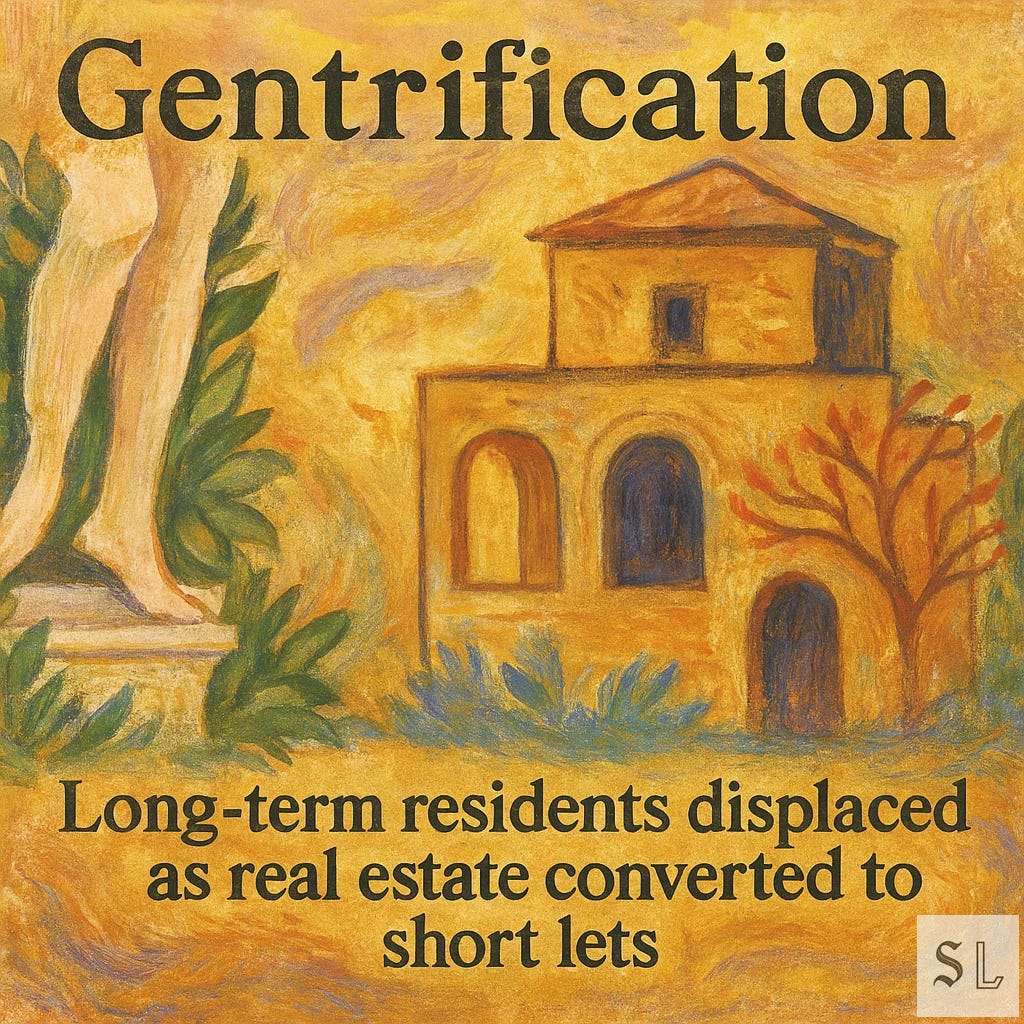
What Season 2 Taught Us:
The closer a place sits to spectacle and decay, the faster it converts. Taormina didn’t just benefit from exposure, it absorbed the show’s mood wholesale, from €5,000 suites to water rationing just beyond the frame. In Season 2, the aesthetic wasn’t a backdrop. It was a booking engine.
Case Study 3: Thailand (Season 3) — The Preemptive Booking Economy
By Season 3, the pattern was obvious. But this time, the destination knew it.
Thailand didn’t wait for the premiere. It launched a campaign, built a microsite, and drafted messaging tied directly to the show — before a single episode aired.
No more reactionary responses, now choreography.
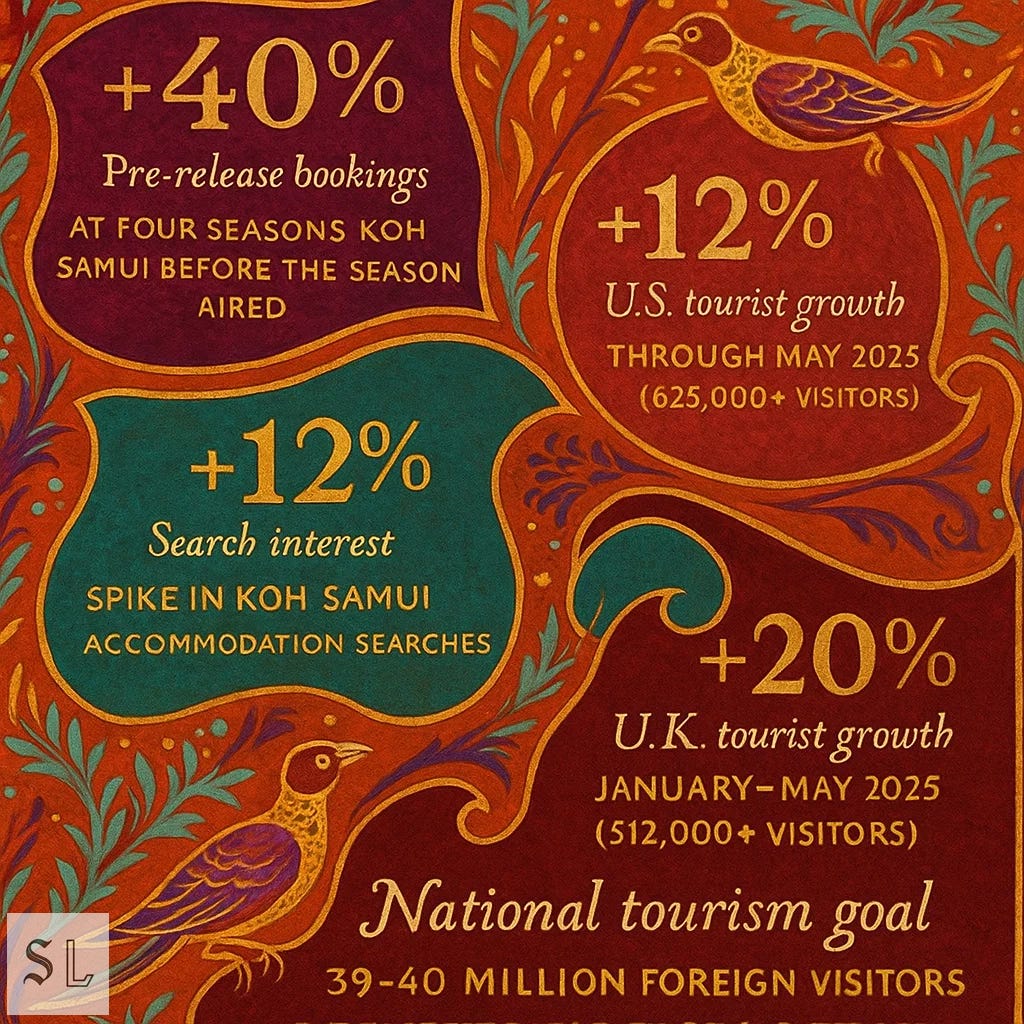
The impact was immediate — and measurable. Pre-release bookings at Four Seasons Koh Samui rose by 40% before the season even aired. Search interest for the region jumped 12%. U.S. and U.K. tourist growth followed suit, and Thailand’s national tourism board publicly targeted 39–40 million foreign visitors for 2025 — a goal explicitly aligned with The White Lotus premiere. This wasn’t ambient interest. It was coordinated demand, activated in advance.
The bookings came before the plot, the hotel reveal, and before the murder.
That’s how trained the audience had become and how ready Thailand was to receive them. By the time the season premiered, Koh Samui was already surging. The government had launched a tourism microsite, resorts had adjusted rates, and the messaging was coordinated down to the phrasing: “Thailand is well-prepared to welcome jet-setting visitors.”
This was pre-release orchestration instead of post-release reactions. Season 3 was the convergence of narrative anticipation and policy choreography.
And while the economic uplift was clear, so was the shift in how destinations understood themselves: Not as places, but as formats. Not waiting to be discovered — but preparing to be consumed.
The 7 Second-Order Effects of The White Lotus Phenomenon
Three seasons in, the patterns are no longer anecdotal but structural. And what started as an ironic prestige drama has become a replicable mechanism — economic, ecological, and infrastructural. So what have we learned and what can we take away?
1. The Anthology Advantage
Each season generates fresh demand while sustaining brand momentum — a serial tourism engine disguised as an HBO original.
The White Lotus didn’t just put places on the map, it taught destinations how to reset theirs. Each season triggered 425%+ search spikes, far surpassing the slow-burn trajectory of single-location franchises like Game of Thrones. But more importantly, the anthology structure let each location start fresh… and smarter. With every new season, destinations could iterate: adjust pricing, build policy, and ride the prestige wave with slightly more precision. Attention wasn’t just captured — it was recycled.
2. The Luxury Tourism Multiplier
The economic returns aren’t just high — they’re concentrated. Screen tourists spend more, stay longer, and drive value far beyond the resort lobby.
Luxury tourism doesn’t just boost economies, it concentrates the benefit. Screen tourists spend 23% more, stay longer, and activate a 2.3x GDP multiplier, generating $1.30 for every dollar they drop. The Four Seasons saw the clearest upside: featured properties outperformed market benchmarks by up to 55% in RevPAR. This isn’t background revenue. It’s precision-targeted, high-yield tourism engineered by narrative exposure.
3. Environmental Tipping Points
Tourism arrives faster than ecosystems can adapt. The result is reef degradation, freshwater strain, and irreversible damage with no management buffer.
The ecological cost isn’t theoretical, it’s logged. In Hawaii, reef zones near filming sites showed elevated levels of sunscreen-linked toxins. Trail systems saw a 40% erosion spike. In Sicily, tourists got spa jets while residents got water rationing. And if any of this feels alarmist, remember Maya Bay: once a The Beach fan pilgrimage, now permanently closed due to ecosystem collapse. Prestige TV might not build infrastructure, but it reshapes environments — quickly, and not always reversibly.
4. The Four Seasons Strategic Masterstroke
No brand has benefited more. Featured in all three seasons, Four Seasons quietly converted screen time into shareholder value — without ever buying an ad.
No brand has extracted more value from The White Lotus than Four Seasons. All three seasons were shot on its properties without overt branding, but with total franchise alignment. After Season 2, the company launched its “Based on a True Stay” campaign and began leveraging screen tourism across its portfolio, from Emily in Paris to Pretty Woman. The ownership structure only sharpens the context: 71% Bill Gates, 24% Prince Al-Waleed. This isn’t product placement, it’s narrative monetisation at the asset level.
5. Government Tourism Strategy Evolution
Tourism boards are no longer reacting to demand. They’re planning around screen releases.
The White Lotus didn’t just impact bookings, it reshaped how nations market themselves. Thailand launched its official “White Lotus Thailand” microsite before Season 3 even aired. Sicily, by contrast, saw a 300% spike in inquiries but had no coordinated response. The global shift is clear: tourism authorities now plan around prestige television the way they used to plan around summer holidays. And the long-view model? Still New Zealand, whose Lord of the Rings campaign remains the benchmark for how to turn screen tourism into sustainable strategy. Everyone else is catching up one season at a time.
6. Comparative Historical Context
Prestige TV has succeeded where blockbuster films faltered. The anthology structure isn’t just good storytelling — it’s geopolitical marketing.
The White Lotus isn’t the first piece of media to reshape a place, but it might be the most structurally repeatable. The Beach led to ecological collapse and the indefinite closure of Maya Bay. Game of Thrones forced Dubrovnik to impose visitor caps. But The White Lotus introduced something new: a prestige anthology format that resets annually, reignites desire, and exports scarcity with high-end polish.
7. The Meta-Textual Consumption Dynamic
Audiences don’t miss the critique, they absorb it… then book accordingly. Awareness isn’t a barrier to consumption. It’s part of the invitation.
The performance doesn’t end with the booking. Online, performative awareness consistently outperformed sincerity in White Lotus–tagged posts. Tourists didn’t just want to go, they wanted to signal that they understood why they were going. According to industry reports, 65% of high-end travellers researched filming locations before booking. This wasn’t fandom. It was semiotic fluency. The caption was the real check-in.
Narrative Becomes Place
By now, The White Lotus is no longer a show that features destinations, it creates them in its own light.
Season by season, it has built a replicable framework:
Pick a place
Frame it through irony, dread, and design
Let audiences metabolise the critique, then
Pay for the privilege of recreating it
Prestige television became itinerary. Narrative became infrastructure. Critique became collateral. And yet, everyone plays along: the guests, the governments, the global marketing teams that know better.
🥂 The White Lotus Cheat Sheet
A subscribers-only summary for when your friends say “Wasn’t that show just about rich people being awful in nice places?”


